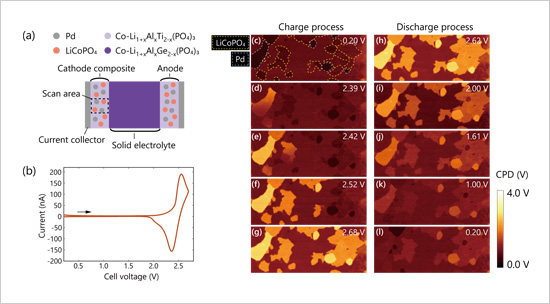Imaging of Sequential Potential Distribution Changes in Electrodes during Charge/Discharge
—Technique Enables In-Depth Analysis of Battery Degradation and May Be Useful in Increasing All-Solid-State Battery Performance—
2020.02.17
National Institute for Materials Science (NIMS)
NIMS has succeeded for the first time in visualizing sequential changes in electrical potential distribution across a composite electrode during charge/discharge reactions in all-solid-state lithium ion batteries. This distribution was previously measureable only before and after the occurrence of charge/discharge reactions. Microscopic understanding of charge/discharge reaction mechanisms in electrodes may facilitate the design of new devices capable of improving the performance of all-solid-state lithium ion batteries.
Abstract
- NIMS has succeeded for the first time in visualizing sequential changes in electrical potential distribution across a composite electrode during charge/discharge reactions in all-solid-state lithium ion batteries. This distribution was previously measureable only before and after the occurrence of charge/discharge reactions. Microscopic understanding of charge/discharge reaction mechanisms in electrodes may facilitate the design of new devices capable of improving the performance of all-solid-state lithium ion batteries.
- The all-solid-state lithium ion battery is a promising next-generation battery candidate because of its excellent safety and cyclic properties. Its performance needs to be further improved before it can be put into practical use. The causes of performance degradation need to be identified through close analysis of electrochemical reactions occurring in electrodes during charge and discharge. In 2016 this research team developed a technique enabling in-situ observation of electrical potential changes in electrodes at high spatial resolution. However, a great deal of interest existed in the development of new techniques that would enable more detailed analyses: sequential (dynamic) measurement of changes in electrical potential distribution across an electrode during charge/discharge.
- This research team recently developed a new technique capable of visualizing sequential (dynamic) changes in electrical potential distribution in batteries by combining an electrochemical measurement system with previously developed techniques (in-situ Kelvin probe force microscopy and a technique used to prepare cross-sectional battery samples). The team then used this new combined technique to observe charge/discharge reactions in action within composite cathodes in all-solid-state lithium ion batteries (experimental samples supplied by Taiyo Yuden Co., Ltd.). As a result, the team found that charge reactions extend unevenly across the composite cathode from the current collector side to the anode side, whereas discharge reactions spread evenly across the cathode. These results indicate the formation of an inadequate electronic conductive path network in the composite cathode during a charge process.
- The technique developed in this research is applicable to a variety of battery evaluations, including in-depth analysis of the causes of battery performance degradation, which have been difficult to ascertain using conventional electrochemical measurements. This technique may help battery developers optimize battery structures and design higher performance batteries.
- This project was carried out by a research team led by Nobuyuki Ishida (Senior Researcher, Surface Characterization Group, Research Center for Advanced Measurement and Characterization (RCAMC), NIMS) and Hideki Masuda (Postdoctoral Researcher, Surface Characterization Group, RCAMC, NIMS; currently affiliated with the University of Tsukuba).
Part of this work was conducted in conjunction with another project entitled “Formation of super-ion conduction path in all-solid-state lithium ion rechargeable battery through design of the crystal phase-interface with hierarchically controlled structures” (which is a part of a larger project entitled “Creation of innovative functional materials with advanced properties by hyper-nano-space design” funded by the JST Strategic Basic Research Program CREST). This work was also supported in part by the Global Research Center for Environment and Energy based on Nanomaterials Science (GREEN), which was established under the MEXT Program for Integrated Materials Development. This project was conducted at the NIMS Battery Research Platform facility.
This study was shaped into a research paper through the joint authorship of NIMS and Taiyo Yuden Co., Ltd. and published in Communications Chemistry, an open access journal, on December 12, 2019, GMT.

Figure. Changes in electrical potential distribution across a composite cathode during charge (a–f) and discharge (g–l) processes
Related files
- Research Center for Advanced Measurement and Characterization
Contacts
(Regarding this research)
-
Nobuyuki Ishida
Senior Researcher,
Surface Characterization Group,
Research Center for Advanced Measurement and Characterization,
National Institute for Materials Science (NIMS)
Tel: +81-860-4972
E-Mail: ishida.nobuyuki=nims.go.jp
(Please change "=" to "@")
(General information)
-
Public Relations Office
National Institute for Materials Sciences
Tel: +81-29-859-2026
Fax: +81-29-859-2017
E-Mail: pressrelease=ml.nims.go.jp
(Please change "=" to "@")
Same Keywords
-
Discovery of Energy Storage Mechanisms in Electrically Conductive Coordination Frameworks
(electrode,battery)
2018.05.31
-
Development of a Model Capable of Predicting the Cycle Lives of High-Energy-Density Lithium-Metal Batteries
(battery)
2024.07.24
-
Development of a Technology Enabling the Fabrication of Rechargeable Magnesium Batteries in a Dry Air Atmosphere
(battery)
2023.05.16
